
 |
Blessing Mbatha
University of South Africa
This article reports on the pedagogical value of Web 2.0 tools at Unisa (i.e., whether these tools can improve teaching and learning). A quantitative approach was used to conduct the study, with a questionnaire as a data collection instrument. The sample size was 301 lecturers drawn using stratified sampling, with proportional allocation drawn from all Unisa colleges. Descriptive statistics were employed to analyse and interpret the data. The results show that Web 2.0 tools are playing a pivotal role when it comes to opening avenues and collapsing the transactional distance in an ODL institution. A combination of web technology and the trend of constructivism can transform the learning process. This article therefore recommends that Unisa sensitise its lecturers to the adoption of Web 2.0 tools as an innovative way to improve teaching and learning.
Keywords: Distance education; open distance learning; Web 2.0; new media; electronic learning; distributed learning
Many global tertiary institutions are beginning to embrace social media and are realising the pedagogical value and implications these social media have for teaching and learning. There are various social media tools that can be used to bridge the transactional distance between students and lecturers. Some of these popular social media tools include Facebook, MySpace, YouTube, Twitter, blogs, and so on. By using a survey instrument, the research being reported here sought to identify the pedagogical value of Web 2.0 tools at the University of South Africa (Unisa) in order to improve the university’s services to students, ensure a seamless learning experience, and bridge the transactional distance in the university’s open distance learning context. The pedagogical value of these tools can also be understood through the exploration of the transition currently taking place in higher education. Higher education is in the process of transition from the traditional model of learning to a new, socially mediated model (Mbatha, 2013). The new, socially mediated model has been spearheaded by the advent of new media tools such as Web 2.0 approaches (Maree, 2011; Mbatha, 2013). These approaches include social networks such as Facebook, Twitter, and YouTube. These tools have been buttressed by numerous researchers acting as catalysts in improving teaching and learning, particularly in distance education (Mbatha & Manana, 2012; Mbatha, 2013). This transition is currently being witnessed all over the world and Unisa is no exception. It is therefore fitting to focus the current study in this mega ODL university.
Sonnekus, Louw, and Wilson (2006, p. 46) observe that “Unisa was founded in 1873 as a university college offering correspondence courses”. They add that over the years, “the university underwent various developmental stages of distance education and, in January 2004, was reconfigured as a comprehensive open distance learning (ODL) university after being amalgamated with two similar educational bodies”. The ‘new’ Unisa has effectively become the fifth largest ODL education institution in the world, and services approximately 450,000 learners (Sonnekus, Louw, & Wilson, 2006). Students at Unisa are from a plethora of geographical backgrounds, ranging from rural, urban, and peri-urban environments; Unisa’s learners also include overseas learners. These geographical differences impact on the university’s service delivery, which has a mandate to enrol a large and diverse student body. Mbatha, Naidoo, and Ngwenya (2010) point out that “not only is the infrastructure in these areas vastly different, but so is the level of exposure to and availability of modern technology”. This, in turn, influences the level of technical support that can be provided through a learner support system.
The research was based on the assumption that Web 2.0 tools facilitate and open avenues for effective teaching and learning: This is because these tools can collapse the transactional distance between students and the institution by allowing easy access to course material, regardless of the student or the lecturer’s time and location.
The problem that was investigated, and which forms the basis of this article, pertains to educational traditionalists’ dichotomous approach to teaching, an approach that obliges them to have a high regard for established practices of teaching and learning and to reject new media as being dangerous and seductive (Lister, Dovey, Giddings, Grant, & Kelly, 2003). In this study, the researcher intends to identify the perceived benefits of using new media as far as teaching and learning are concerned. One of the major reasons (or, at least, so it is believed) that some academics do not embrace the transition at Unisa is because they lack knowledge on how Web 2.0 tools can be adopted to improve teaching and learning. One of the problems encountered in this research study stemmed from the fact that little has been written at Unisa on how Web 2.0 tools can be used to enhance teaching and learning. The current study therefore also intends to close this gap and add to the body of knowledge. The fear is that if this problem is not properly addressed the current transition at Unisa may not be successful.
Fang and Li (2013, p. 458) assert that “Web 2.0 has become a hot topic in the research of new generation network-related development and application”. In support of this view, Paily (2013) notes that new developments in the area of ICTs in general and Web 2.0 in particular have provided a variety of tools and resources for designing and delivering instruction based on constructivist principles. Hence it is difficult to circumvent the effect that Web 2.0 approaches have had in the early part of the 21st century (Bennett, Bishop, Dalgarno, Waycott, & Kennedy 2012; Sacks & Graves, 2012; Mbatha, 2013).
This study adopted the three part model of interaction posited by Moore (1999) as its theoretical framework. Moore (1999) outlines three types of interaction that are crucial for learning and engagement: “learner-content, learner-instructor, and learner-learner”.
a) Learner-content interaction
This can best be described as an interaction between the learner and the content or subject of study. Moore and Kearsley (1996) describe the learner-content interaction as “involving a process of individual learners elaborating and reflecting on the subject matter or the course content”. These authors note that, “unlike learner-instructor or learner-learner interactions, only the learner is directly involved in learner-content interaction”.
b) Learner-instructor interaction
Moore and Kearsley (1996) note that this is basically “the interaction between the learner and the expert who prepared the subject material”.
c) Learner-learner interaction
Moore and Kearsley (1996) observe that this is “the interaction between one learner and other learners, alone or in group settings, with or without the real-time presence of an instructor”. They describe the learner-learner interaction as a “two-way reciprocal communication between or among learners who exchange information, knowledge, thoughts, or ideas regarding course content, with or without the presence of an instructor”. However, for teaching and learning to be realised, some kind of interaction has to take place. This could involve the student engaging with his/her study material, or a lecturer making use of learning resources to impart skills to the students. Anderson (2010) defines interaction as the key in fostering, supporting, and engaging learning. Likewise, Moore and Kearsley (1996) note that “interaction has been deemed one of the most important components in distance education owing to the isolation of instructors and learners”.
A paper-based survey method was deemed to be an appropriate instrument for measuring lecturers’ perceptions regarding the use of Web 2.0 as a method of improving teaching and learning at Unisa. Also, the researcher decided on a survey method because this method is a relatively quick and cheap way of obtaining data from a targeted population. It is also a very effective and reliable quantitative method of obtaining data. It allowed the researcher to carefully choose the population and to organise the data and present it systematically; finally, this method of data collection also makes interpretation of data relatively easy. Given the diverse nature of the Unisa community and the large size of this community, the researcher narrowed down the focus of this study to Unisa’s main hub, which is located in Pretoria (Tshwane) in South Africa. In this region, lecturers were targeted across all colleges to get their views on the adoption of Web 2.0 as a means of improving teaching and learning at Unisa. For this study, it was vital that the researcher established lecturers’ perceptions on Unisa’s e-learning, simply because lecturers play a major role in the success of this initiative. Stratified random sampling with proportional allocations was used to select lecturers across all colleges at Unisa (see Table 1). Systematic sampling was then used within each stratum. Stratified random sampling is a probability sampling technique that enables a researcher to select elements randomly by first putting them into non-overlapping homogeneous groups called strata. A random sample is then selected from each stratum using either simple random sampling or systematic sampling. Probability samples are used in such a way that the researcher can generalise the results to the population, thus ensuring external validity. In order to conduct an in-depth study and to acquire a demonstrable degree of reliability and validity, the researcher used stratified random sampling to select the population sample. The sample size was 301 lecturers drawn by stratified sampling with proportional allocation drawn from all Unisa colleges. A total of 301 participants was selected because a smaller sample is more manageable and less costly. All 301 questionnaires distributed were returned and usable.
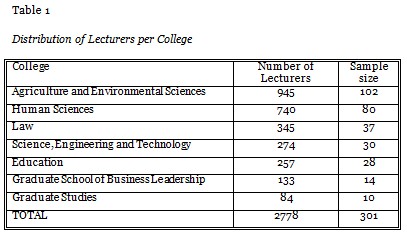
A self-administered questionnaire consisting of both structured and non-structured questions was used. As already mentioned, questionnaires are a cheap and cost-effective method of collecting data. Also, in this case, the validity of the data collection instrument was enhanced by the fact that questions were based on the objectives of this research study. Each question was checked to determine whether it contributed to the research objectives. As far as internal validity was concerned, the researcher scrutinised the work critically to ensure that the research assistants adhered to the topic and thus that the study measured what it was intended to measure. Internal validity was also ensured by reviewing studies by other researchers in the same field. With regard to reliability, the research instrument was pre-tested in a pilot study for clarity, completeness, relevance, and shortcomings. The pilot study aimed to test the subject matter of the current research, the population it was to cover, its spatial variability, and respondents’ possible reactions to questions. The reliability of the research instrument was improved by including both closed-ended and open-ended questions in the survey. The researcher made sure that the wording of the questions was simple, direct, and unbiased. Data was analysed by using descriptive statistics and the Statistical Package of Social Sciences. Relationships among variables were compared and interpretations made. Descriptive statistics were employed to further analyse and interpret the data.
As far as ethical considerations were concerned, informed consent was obtained from each participant in the study in order to ensure that each participant fully understood what he or she was doing and to verify the fact that he or she was willing to participate in the study. The respondents were assured of their rights, including the right of consent, protection from disclosure of information, and respect for their privacy. All the research participants participated voluntarily and none were forced to take part in the study. With regard to protection from harm, the researcher ensured that the participants were not at any risk and would not be exposed to embarrassment, unusual stress, or any demeaning treatment. Anonymity and confidentiality were promised and maintained. The information that participants provided was not made available to anyone who was not directly involved in the study and no information could be traced to any participant. The researcher also ensured that participants remained anonymous throughout the study. In terms of professional standards, the researcher ensured that the results were collected in a professional manner without misrepresenting anyone and/or intentionally misleading the respondents about the nature of the study. The researcher ensured that all the results were presented honestly without fabricating any data to support any particular finding.
Background information sought from the respondents included age, college attachment, gender, and highest educational attainment. These structured questions were asked in order to determine the relationships between demographic characteristics and Unisa lecturers’ use of Web 2.0 tools. The majority of respondents were females (189, 63%). This was not at all surprising, given that there are more females than males at Unisa. Some studies have identified women and girls as disadvantaged in their uptake of ICTs (Mbatha, Ocholla, & Le Roux, 2011). The majority of respondents (233, 77%) were between the ages of 29 to 34, followed by those who were between 35 to 40 years old (45, 15%). Only 23 (8%) of the respondents were over 50 years of age. The aim of requesting respondents to indicate their age was two-fold: first to ascertain the distribution of respondents by age, and secondly to establish whether there was any correlation between respondents’ age and their use of Web 2.0 tools. As far as educational background was concerned, most respondents had master’s degrees (178, 59%), followed by those who had doctoral degrees (89, 30%). Only 34 (11%) were professors.
Respondents were asked to indicate which types of Web 2.0 tools are essential for improving teaching and learning. Respondents were therefore provided with a list of Web 2.0 tools and asked to rate each of them on a Likert scale of 1 to 5 (1= strongly agree [SA]; 2 = agree [A]; 3 = not sure [NS]; 4 = disagree [D]; and 5 = strongly disagree [SD]). Table 2 presents the results.
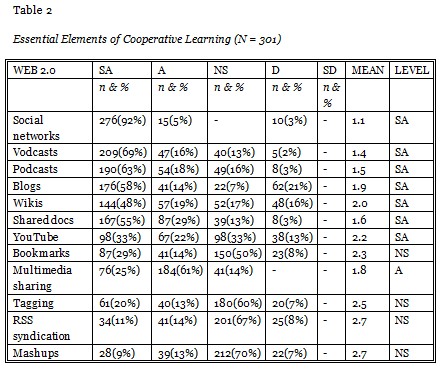
As Table 2 shows, the majority of respondents believe that social networks are essential elements of cooperative learning. This is evident when combining positive phenomenon, that is levels 1 and 2 which adds up to 291 (97%). Only 10 (3%) of the respondents disagreed with the statement, implying that these respondents do not regard social networks as essential elements of cooperative learning. Likewise, those who indicated that vodcasts were essential elements were also significant, a total rating of 256 (85%) at the combined levels 1 and 2 as they are both positive phenomenon. Forty (13%) were unsure, while only 5 (2%) disagreed with the assertion. Similarly, a significant number of respondents (244, 81%), when combining levels 1 and 2, indicated that podcasts are essential elements in teaching and learning. A minority (8, 3%) disagreed with this statement that podcasts are essential elements of cooperative learning. Blogs were also regarded as essential elements in teaching and learning, as can be seen from the answers of a significant number of respondents (217, 72%) when combining levels 1 and 2 respectively. Those who indicated that wikis were essential elements of cooperative learning were also significant (201, 66%, levels 1 and 2 combined respectively), while 48 (16%) disagreed. It is also clear from Table 2 that Web 2.0 applications such as shared documents, YouTube, and multimedia sharing were regarded by the majority of respondents as essential elements of cooperative learning.
One of the objectives of the study was to establish whether respondents were familiar with the characteristics of Web 2.0 tools. The respondents were therefore provided with a list of possible characteristics of Web 2.0 tools and asked to rate each one of them on a Likert scale of 1 to 5 (1 = strongly agree [SA]; 2 = agree [A]; 3 = not sure [NS]; 4 = disagree [D]; and 5 = strongly disagree [SD]). The results are shown in Table 3.
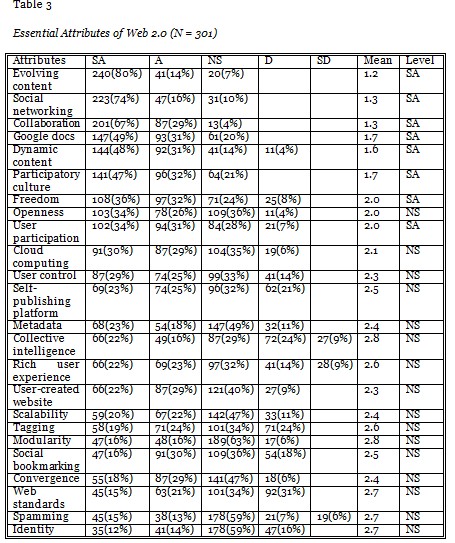
Table 3 depicts that the majority of respondents when combining levels 1 and 2 (288, 96%) strongly agreed with the statement that collaboration is a Web 2.0 attribute. Interestingly, only 13 (4%) were not sure about the statement. Openness was also considered as one of the attributes (181, 60%, levels 1 and 2 combined). Also of note is that those who were not sure about the statement were almost average (109, 36%), while only 11 (4%) totally disagreed with the assertion. Forty-five (15%) strongly agreed that Web standards were essential attributes, and those who simply agreed numbered 63 (21%). Notably, 92 (31%) of respondents disagreed with the statement. Of respondents, 189 (63%) were not sure whether modularity was one of the essential attributes of Web 2.0, while 17 (6%) totally disagreed with the statement. Evolving content was undoubtedly regarded by the majority (281, 93%) as one of the essential attributes of Web 2.0. Those who mentioned that user control was an essential attribute were also the majority, a fact which is evident when levels 1 and 2 are combined, given that they represent a positive phenomenon in this instance (161, 53%). As far as identity is concerned, a large number of respondents (178, 59%) were unsure about the statement. The majority (153, 51%, levels 1 and 2 combined) regarded user-created websites as one of the essential attributes of Web 2.0. Unsurprisingly, a total of 270 (90%, levels 1 and 2 combined) respondents considered social networking as an essential attribute, while only 31 (10%) were unsure of the claim. It is also important to note that Web 2.0 attributes such as self-publishing platforms, tagging, social bookmarking, convergence, cloud computing, rich use experience, and user participation were regarded by many respondents as essential attributes. Again, dynamic content, freedom, collective intelligence, participatory culture, and Google docs were considered as essential attributes. This is evident when levels 1 and 2 are combined, since both represent a positive phenomenon.
One of the objectives of the study was to establish whether respondents were aware of the pedagogical value of Web 2.0 tools in an ODL context. The respondents were provided with a list of possible benefits of using Web 2.0 tools and asked to rate each one of them on a Likert scale (1 = strongly agree [SA]; 2 = agree [A]; 3 = not sure [NS]; 4 = disagree [D]; and 5 = strongly disagree [SD]). The results are shown in Table 4.
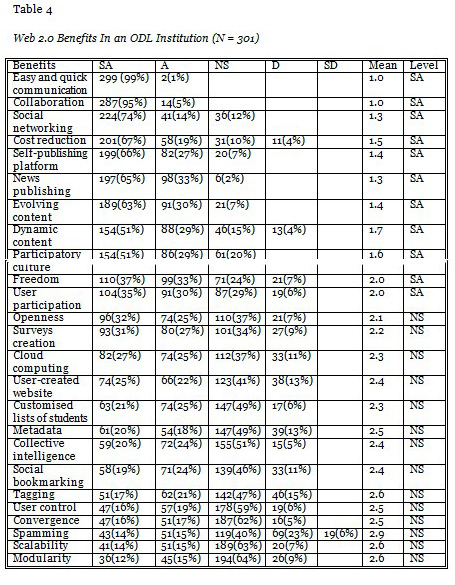
Table 4 shows that all respondents (301, 100%) at the combined levels of 1 and 2 (remember that these both represent a positive phenomenon) indicated that collaboration is one of the benefits of using Web 2.0 tools for teaching and learning. Openness was also considered by many (170, 56%) as an advantage, while only 21 (7%) totally disagreed. A significant number of respondents (194, 64%) were unsure about whether or not modularity was one of the benefits. Those who indicated that evolving content was one of the benefits formed a significant majority (208, 93%, when levels 1 and 2 are combined). When it comes to user control, the majority of respondents (178, 59%) indicated that they were unsure about the truth of the assertion. User created websites was also regarded as one of the benefits (140, 47%, levels 1 and 2 combined), while 265 (88%, levels 1 and 2 combined) respondents were of the view that social networking was one of the benefits. As far as self-publishing platforms are concerned, the majority (281, 93%) mentioned that such platforms were part of the benefits of Web 2.0.
Table 4 also shows that the majority of respondents were unsure about the educational benefits of the following Web 2.0 tools: tagging, social bookmarking, convergence, spamming, metadata, scalability, collective intelligence, and customised lists of students. Cloud computing was regarded by many (156, 52%) as one of the benefits, while 195 (65%) indicated that user participation was a benefit. A total of 242 (80%, levels 1 and 2 combined) respondents were of the opinion that dynamic content was one of the benefits, while 209 (69%) revealed that freedom was also a benefit. Likewise, a significant number of the respondents indicated participatory culture as one of the benefits. Unsurprisingly, all the respondents (301, 100%, levels 1 and 2 combined) were of the view that easy and quick communication was one of the benefits, while news publishing was also indicated as a benefit (295, 98%, levels 1 and 2 combined). Those who mentioned that survey creation was also a benefit were also significant (173, 57%, levels 1 and 2 combined), while a very large number of respondents (259, 86%, levels 1 and 2 combined) regarded cost reduction as one of the benefits of using Web 2.0 applications in an ODL institution.
Although the main focus of the study was to identify the pedagogical value of Web 2.0 tools in improving teaching and learning, the researchers also deemed it necessary to identify the challenges (to both lecturers and students) of using these tools. This was to ensure that challenges that hamper the effective usage of Web 2.0 tools are identified and dealt with accordingly. Respondents were therefore provided with a list of possible challenges and asked to rate each one of them on a Likert scale of 1 to 5 (1 = strongly agree [SA]; 2 = agree [A]; 3 = not sure [NS]; 4 = disagree [D]; and 5 = strongly disagree [SD]). The results are summarised in Table 5.
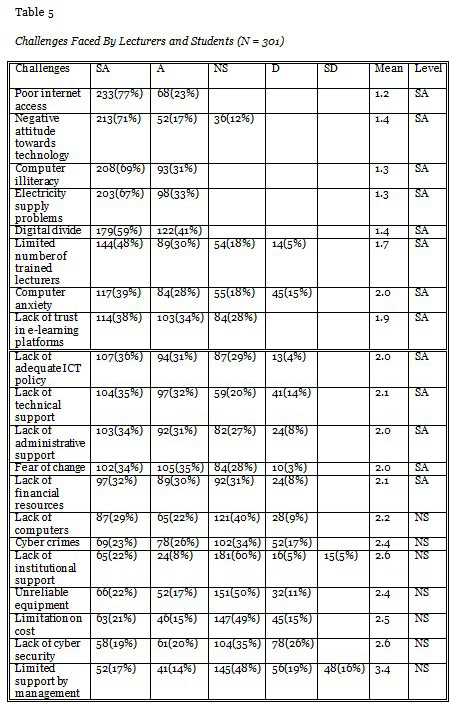
Table 5 shows that all respondents (301, 100%, when levels 1 and 2 are combined since both represent a positive phenomenon) indicated that the digital divide was a challenge faced by lecturers and students in the use of Web 2.0 tools to improve teaching and learning. Computer illiteracy was also identified by all the respondents (301, 100%, at the combined levels 1 and 2) as a major challenge. Again, when it comes to problems with the electricity supply, all respondents (301, 100% when levels 1 and 2 are combined) indicated that this was indeed a barrier as far as the effective use of Web 2.0 tools was concerned. The majority (147, 49%) believe that cybercrime is also a barrier, while 52 (17%) respondents disagreed.
Fifty percent of the respondents (152) were of the view that lack of computers was one of the challenges, while all respondents (301, 100%, levels 1 and 2 combined) shared similar sentiments (i.e., that poor internet access was also a challenge). Also of note is the fact that the results shown in Table 5 demonstrate that the majority of respondents believe that some of the challenges include lack of cyber security, lack of trust in e-learning platforms, lack of adequate ICT policy, lack of financial resources, and the fact that there is a limited number of trained lecturers available. Likewise, 265 (88%) of respondents indicated that negative attitude towards technology was a challenge to the use of Web 2.0 tools, while a significant number (201, 67%) mentioned that computer anxiety was one of the challenges. Similarly, many respondents indicated that fear of change, lack of technical support, and lack of administrative support were also challenges. Interestingly, a large number of respondents (181, 60%) were unsure about whether or not lack of support was one of the challenges. About half of the respondents (145, 48%) were unsure about whether or not limited management support (i.e., management of the institution) was one of the challenges in the use of Web 2.0 tools.
When asked to indicate the types of Web 2.0 tools that are essential for enhancing teaching and learning, the majority of respondents were of the view that tools such as social networks, vodcasts, blogs, Wikis, shared documents, YouTube, and multimedia sharing were essential elements of cooperative learning. In terms of the essential attributes of Web 2.0, a significant number of respondents indicated that collaboration, openness, evolving content, user control, user-created websites, social networking, self-publishing platforms, tagging, social bookmarking, convergence, cloud computing, rich use experience, and user participation were all regarded by many respondents as essential attributes. Dynamic content, freedom, collective intelligence, participatory culture, and Google docs were also considered as essential attributes of Web 2.0.
In terms of the benefits of Web 2.0 tools in an ODL context, unsurprisingly, many respondents indicated the following as some of the benefits of using Web 2.0 tools in an ODL learning environment: collaboration, openness, evolving content, user-created websites, user control, social networking, self-publishing platforms, cloud computing, dynamic content, participatory culture, easy and quick communication, online surveys creation, and cost reduction. Interpreted in light of the three part model of interaction, which was adopted as a framework for this article, there are three types of interaction that are essential for learning and engagement, one of which being learner-content interaction (Moore, 1999). In line with this model, this research study established the fact that Web 2.0 tools promote interaction between the learner and the content or subject of study. Also, the model describes the “learner-instructor interaction” as one of the interactions that are fundamental in an ODL environment (Moore, 1999). This is evident in the results of this study, where a majority of respondents indicated that Web 2.0 tools improve communication and collaboration – and communication and collaboration can obviously exist between students and lecturers.
In support of the results of this study, Sacks and Graves (2012) are of the view that “Web 2.0 tools allow users to interact and collaborate with each other in a social media dialogue as creators of user-generated content in a virtual community”. This is in contrast to those websites that only allow visitors to view them passively. As Stanciu, Mihai, and Aleca (2012) note, there are many possible uses of Web 2.0 tools in education, all of which possess a certain amount of educational value. Bogdan, Patrut, and Cmeciu (2013) are of the view that Web 2.0 tools have “emerged as an important tool in the creation and exchange of user-generated content and social interaction”. In support of the results of this study, Olive (2013) claims that Web 2.0 tools offer lecturers and students new media for teaching and learning both inside and outside the lecture room.
For this study, it was important to establish respondents’ views regarding the challenges they encounter in using Web 2.0 tools to improve teaching and learning. This was obviously important in order to identify strategies that can be used to overcome these challenges and problems. Table 5 shows that there are many challenges that hamper the effective and optimal use of Web 2.0 tools at Unisa. The most common problems include the digital divide, cybercrime, poor internet access, computer illiteracy, limited supply of electricity in some areas in South Africa (and especially in other African countries – note that the majority of Unisa students are from South Africa and elsewhere in Africa). Expectedly, lack of computers was also one of the major challenges. It is important to note that Unisa has and is continuing to ensure that all its students have access to the relevant technology required to enable them to study effectively and efficiently online. Some of these technologies include access to notebooks and internet access. This initiative is intended to end the digital divide that exists in Unisa’s student body as a whole.
Interestingly and understandably so, many respondents revealed that lack of cyber security, lack of trust of e-learning platforms, lack of adequate ICT policy, lack of financial resources, and limited trained lecturers, negative attitude towards technology, computer anxiety, fear of change, lack of technical support, lack of administrative support were also challenges. These results can be attributed to the fact that Unisa has yet to design a policy that can protect academics against certain real cyber threats when using Web 2.0 tools for teaching and learning. In line with these results, Kleiner, Thomas, and Lewis (2007) conducted a study on the development of educational technologies and found that teachers’ reluctance to use these technologies plays a key role in the non-integration of these new technologies in education. Likewise, Stanciu, Mihai, and Aleca (2012, p. 57) established the fact that many teachers still consider social networking sites as little more than virtual playgrounds for their students.
The primary aim of this article was to shed some light on the pedagogical value of Web 2.0 tools at Unisa in order to improve the university’s services to its students. This research study was based on the assumption that Web 2.0 tools facilitate and open avenues for effective teaching and learning because these tools can collapse the transactional distance between students and the institution by allowing easy access to course material, regardless of either the student or the lecturer’s time and location. This assumption has proved to be true, since the results of this study show that Web 2.0 tools are catalysts in enhancing teaching and learning. Based on the results of this study, the researcher recommends that a task force be formed which will provide proper guidance and a baseline set of recommendations for the adoption and management of Web 2.0 and social software throughout Unisa. This recommendation is based on the fact that Web 2.0 tools were initially designed for recreational or social purposes. Hence many people still consider these tools as social technologies which cannot be used for non-recreational purposes.
This study has established that Web 2.0 tools are, in fact, capable of enhancing teaching and learning, particularly in an ODL environment. The transactional distance between all stakeholders involved in the learning process can best be bridged through the adoption of Web 2.0 tools. Tertiary institutions should create their own task teams which implement this guidance and create specific policies to guide the use of Web 2.0 and social software in their modes of teaching and learning. Academics should be encouraged to explore these tools themselves, and to visit the institutional presence in various social software venues. The best way to maintain an effective presence on the web is to encourage and enable participation among staff members, with the emphasis on academics (simply because it is the academics who interact with students). The institutional ICT Department needs to develop a policy for official interaction, and staff members should be permitted to participate in this policy development process. The advantages of this kind of controlled, informal interaction are significant, since this type of interaction naturally creates broad platforms that can be used to interact with the student body. While care must be taken to properly represent official institution positions and maintain accuracy of information, the nature of this environment can make an institution more connected with the students, and vice versa. Keeping an active, public Web 2.0 presence can allow institutions to meet the public, potential students, and their own staff members in environments they are increasingly a part of.
One of the issues in the educational use of social media tools is the lack of security on these sites; this issue has led to a great deal of heated debate, and is one of the reasons why many people have and are continuing to vehemently oppose the adoption of these tools in education. It is therefore important to note that understanding and addressing security and legal consequences is vital to institutional success in interacting with Web 2.0 approaches. Comprehensive programmes for teaching and learning and awareness should be incorporated into current security and information technology training and policy. Tertiary institutions, including Unisa, should endeavour to prudently and incessantly research and comprehend how innumerable Web 2.0 approaches might best be adopted to enhance teaching and learning. This determination should be incorporated into mechanisms for the assessment and enhancement of existing information processes. The embracing and actual use of Web 2.0 tools necessitates a perfect and defined obligation and backing from the management, and general support at all levels of the institution. Tertiary institutions clearly have the opportunity to utilise Web 2.0 tools as a “springboard” to the more effective use of information, and the more effective capture and transfer of knowledge. This article only reports on the Unisa lecturers’ perceptions regarding adoption and diffusion of Web 2.0 tools to enhance teaching and learning at Unisa. Therefore, a future study is recommended to focus on the students’ perceptions to complete the picture of pedagogical value of Web 2.0 tools at Unisa.
Anderson, T. (2010). Theories for learning with emerging technologies. In G. Veletsianos (Ed.), Emerging technologies in education. Edmonton: AU Press.
Bennett, S., Bishop, A., Dalgarno, B., Waycott, J,. & Kennedy, G. (2012). Implementing Web 2.0 technologies in higher education: A collective case study. Computers & Education, 59(2), 524-534.
Bogdan, P., Patrut, M., & Cmeciu, C. (2013). Social media and the new academic environment: Pedagogical challenges. Hershey, PA: IGI Global.
Drexler, W., Baralt, A., & Dawson, K. (2008). The Teach Web 2.0 Consortium: A tool to promote educational social networking and Web 2.0 use among educators. Educational Media International, 45(4), 271–228.
Fang, H., & Li, X. (2013). Web 2.0 application in subject services of high school libraries. Information Technology Journal, 2(3), 458-461.
Kleiner, B., Thomas, N., & Lewis, L. (2007). Educational technology in teacher education programs for initial licensure (NCES 2008–040). Washington, DC: National Center for Education Statistics, Institute of Education Sciences, U.S. Department of Education.
Lister, M., Dovey, J., Giddings, S., Grant, I., & Kelly, K. (2003). New media: A critical introduction. New York, NY: Routledge.
Maree, C. (2011). Exploring the implications, challenges and potential of new media and learning. On the Horizon, 19(4), 245-252.
Mbatha, B. T. (2013). Facebook: The power source of transforming the learning experience. International Journal for e-Learning Security, 3(1), 23-39.
Mbatha, B. T., & Manana, K.P.P. (2012). Students’ perceptions on the use of Facebook in an ODL landscape. Progressio, 34(1), 13-26.
Mbatha, B. T., Naidoo, L., & Ngwenya, B. (2010). Bridging the transactional gap in open distance learning (ODL): The case of the University of South Africa. Journal Humanities and Social Sciences, 2(1), 64-69.
Moore, M. G. (1999). Three types of interaction. The American Journal of Distance Education, 3(2), 1–6.
Moore, M. G., & Kearsley, G. (1996). Distance education: A systems view. Boston, MA: Wadsworth.
Olive, J. (2013). Dynamic and interactive mathematics learning environments: Opportunities and challenges for future research. Mevlana International Journal of Education, 3(3), 8-24.
Paily, M. U. (2013). Creating constructivist learning environment: Role of “Web 2.0” technology. International Forum of Teaching and Studies, 9(1), 39-50.
Sacks, M. A., & Graves, N. (2012). How many “friends” Do you need? Teaching students how to network using social media. Business Communication Quarterly, 75(1), 80-88.
Sonnekus, T. P., Louw, W., & Wilson, H. (2006). Emergent learner support at the University of South Africa: An informal report. Progression, 28(1 & 2), 44-53.
Stanciu, A., Mihai, F., & Aleca, O. (2012). Social networking as an alternative environment for education. Accounting and Management Information Systems, 11(1), 56–75.